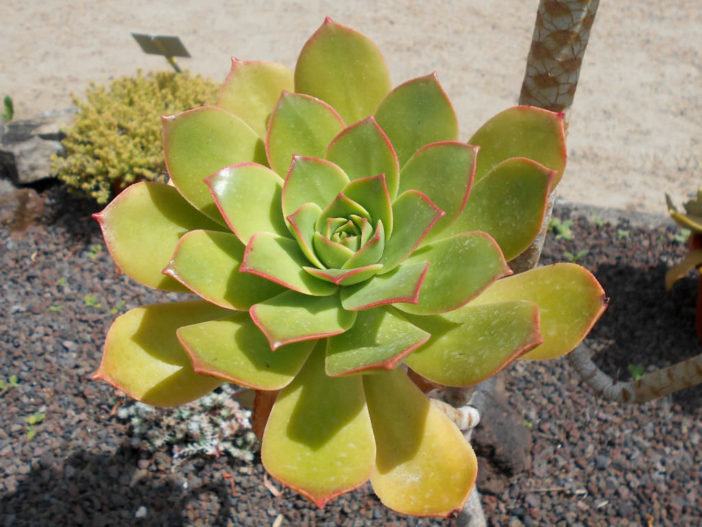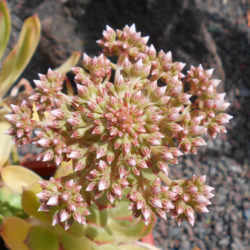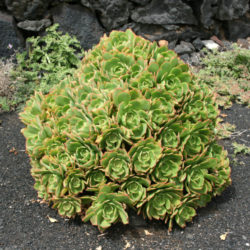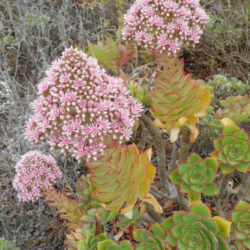Scientific Name
Aeonium lancerottense (Praeger) Praeger
Synonym(s)
Sempervivum lancerottense
Scientific Classification
Family: Crassulaceae
Subfamily: Sempervivoideae
Tribe: Aeonieae
Genus: Aeonium
Origin
Aeonium lancerottense is endemic to the island of Lanzarote in the Canary Islands.
Description
Aeonium lancerottense is a densely branched succulent subshrub with rosettes of fleshy, smooth leaves held on ascending, branching stems. It can grow up to 2 feet (60 cm) tall and 3 feet (90 cm) wide. The rosettes are rather flattish and can reach a diameter of up to 7.2 inches (18 cm). The leaves are green to yellowish-green, often reddish along the margins and at the tip. They are obovate to oblanceolate-spatulate, pointed at the apex, with some wrinkled cilia in the upper part of the margins, measuring up to 3.6 inches (9 cm) long and 1.6 inches (4 cm) wide.
The flowers are star-shaped, with 7 to 8 whitish petals with a pinkish median part, and appear arranged in cone-shaped clusters that rise on strong stalks up to 2 feet (60 cm) above the foliage in summer. The clusters can reach up to 12 inches (30 cm) in height and 10 inches (25 cm) in diameter at the base.

Hardiness
USDA hardiness zones 9a to 11b: from 20 °F (−6.7 °C) to 50 °F (+10 °C).
How to Grow and Care
Aeoniums do not like hot or dry weather. Therefore, they may go dormant in summer and do not require any water except in very dry conditions. In extreme heat, their leaves will curl to prevent excessive water loss. Growing them in moist shade will keep them growing, but their true growth season is winter to spring when temperatures are cool, 65 to 75 °F (18 to 24 °C), and damp. In the winter, water whenever the soil has dried out. Test by poking your finger into the soil an inch or 2 (2.5 to 5 cm). Too much moisture or allowing them to sit in wet soil will cause root rot.
A sandy loam or regular potting mix is better than a mix specifically for cacti and succulents since Aeoniums need some moisture. If you are growing them in containers, repot them every 2 to 3 years with fresh potting soil.
Feed during the growing season with a half-strength balanced fertilizer every month or so. Do not feed while dormant.
See more at How to Grow and Care for Aeonium.
Link
- Back to genus Aeonium
- Succupedia: Browse succulents by Scientific Name, Common Name, Genus, Family, USDA Hardiness Zone, Origin, or cacti by Genus
Photo Gallery
Click on a photo to see a larger version.


